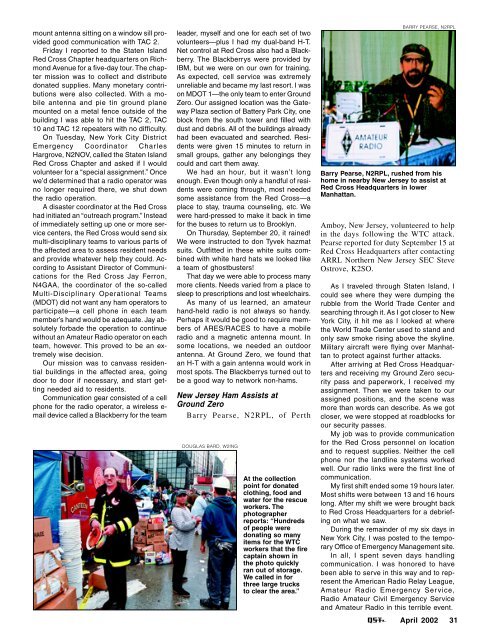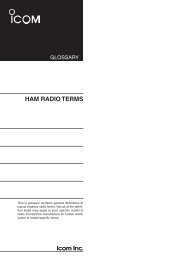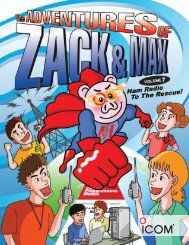SEPT 11 - New York City Amateur Radio Emergency ...
SEPT 11 - New York City Amateur Radio Emergency ...
SEPT 11 - New York City Amateur Radio Emergency ...
You also want an ePaper? Increase the reach of your titles
YUMPU automatically turns print PDFs into web optimized ePapers that Google loves.
mount antenna sitting on a window sill provided<br />
good communication with TAC 2.<br />
Friday I reported to the Staten Island<br />
Red Cross Chapter headquarters on Richmond<br />
Avenue for a five-day tour. The chapter<br />
mission was to collect and distribute<br />
donated supplies. Many monetary contributions<br />
were also collected. With a mobile<br />
antenna and pie tin ground plane<br />
mounted on a metal fence outside of the<br />
building I was able to hit the TAC 2, TAC<br />
10 and TAC 12 repeaters with no difficulty.<br />
On Tuesday, <strong>New</strong> <strong>York</strong> <strong>City</strong> District<br />
<strong>Emergency</strong> Coordinator Charles<br />
Hargrove, N2NOV, called the Staten Island<br />
Red Cross Chapter and asked if I would<br />
volunteer for a “special assignment.” Once<br />
we’d determined that a radio operator was<br />
no longer required there, we shut down<br />
the radio operation.<br />
A disaster coordinator at the Red Cross<br />
had initiated an “outreach program.” Instead<br />
of immediately setting up one or more service<br />
centers, the Red Cross would send six<br />
multi-disciplinary teams to various parts of<br />
the affected area to assess resident needs<br />
and provide whatever help they could. According<br />
to Assistant Director of Communications<br />
for the Red Cross Jay Ferron,<br />
N4GAA, the coordinator of the so-called<br />
Multi-Disciplinary Operational Teams<br />
(MDOT) did not want any ham operators to<br />
participate—a cell phone in each team<br />
member’s hand would be adequate. Jay absolutely<br />
forbade the operation to continue<br />
without an <strong>Amateur</strong> <strong>Radio</strong> operator on each<br />
team, however. This proved to be an extremely<br />
wise decision.<br />
Our mission was to canvass residential<br />
buildings in the affected area, going<br />
door to door if necessary, and start getting<br />
needed aid to residents.<br />
Communication gear consisted of a cell<br />
phone for the radio operator, a wireless email<br />
device called a Blackberry for the team<br />
leader, myself and one for each set of two<br />
volunteers—plus I had my dual-band H-T.<br />
Net control at Red Cross also had a Blackberry.<br />
The Blackberrys were provided by<br />
IBM, but we were on our own for training.<br />
As expected, cell service was extremely<br />
unreliable and became my last resort. I was<br />
on MDOT 1—the only team to enter Ground<br />
Zero. Our assigned location was the Gateway<br />
Plaza section of Battery Park <strong>City</strong>, one<br />
block from the south tower and filled with<br />
dust and debris. All of the buildings already<br />
had been evacuated and searched. Residents<br />
were given 15 minutes to return in<br />
small groups, gather any belongings they<br />
could and cart them away.<br />
We had an hour, but it wasn’t long<br />
enough. Even though only a handful of residents<br />
were coming through, most needed<br />
some assistance from the Red Cross—a<br />
place to stay, trauma counseling, etc. We<br />
were hard-pressed to make it back in time<br />
for the buses to return us to Brooklyn.<br />
On Thursday, September 20, it rained!<br />
We were instructed to don Tyvek hazmat<br />
suits. Outfitted in these white suits combined<br />
with white hard hats we looked like<br />
a team of ghostbusters!<br />
That day we were able to process many<br />
more clients. Needs varied from a place to<br />
sleep to prescriptions and lost wheelchairs.<br />
As many of us learned, an amateur<br />
hand-held radio is not always so handy.<br />
Perhaps it would be good to require members<br />
of ARES/RACES to have a mobile<br />
radio and a magnetic antenna mount. In<br />
some locations, we needed an outdoor<br />
antenna. At Ground Zero, we found that<br />
an H-T with a gain antenna would work in<br />
most spots. The Blackberrys turned out to<br />
be a good way to network non-hams.<br />
<strong>New</strong> Jersey Ham Assists at<br />
Ground Zero<br />
Barry Pearse, N2RPL, of Perth<br />
DOUGLAS BARD, W2ING<br />
At the collection<br />
point for donated<br />
clothing, food and<br />
water for the rescue<br />
workers. The<br />
photographer<br />
reports: “Hundreds<br />
of people were<br />
donating so many<br />
items for the WTC<br />
workers that the fire<br />
captain shown in<br />
the photo quickly<br />
ran out of storage.<br />
We called in for<br />
three large trucks<br />
to clear the area.”<br />
BARRY PEARSE, N2RPL<br />
Barry Pearse, N2RPL, rushed from his<br />
home in nearby <strong>New</strong> Jersey to assist at<br />
Red Cross Headquarters in lower<br />
Manhattan.<br />
Amboy, <strong>New</strong> Jersey, volunteered to help<br />
in the days following the WTC attack.<br />
Pearse reported for duty September 15 at<br />
Red Cross Headquarters after contacting<br />
ARRL Northern <strong>New</strong> Jersey SEC Steve<br />
Ostrove, K2SO.<br />
As I traveled through Staten Island, I<br />
could see where they were dumping the<br />
rubble from the World Trade Center and<br />
searching through it. As I got closer to <strong>New</strong><br />
<strong>York</strong> <strong>City</strong>, it hit me as I looked at where<br />
the World Trade Center used to stand and<br />
only saw smoke rising above the skyline.<br />
Military aircraft were flying over Manhattan<br />
to protect against further attacks.<br />
After arriving at Red Cross Headquarters<br />
and receiving my Ground Zero security<br />
pass and paperwork, I received my<br />
assignment. Then we were taken to our<br />
assigned positions, and the scene was<br />
more than words can describe. As we got<br />
closer, we were stopped at roadblocks for<br />
our security passes.<br />
My job was to provide communication<br />
for the Red Cross personnel on location<br />
and to request supplies. Neither the cell<br />
phone nor the landline systems worked<br />
well. Our radio links were the first line of<br />
communication.<br />
My first shift ended some 19 hours later.<br />
Most shifts were between 13 and 16 hours<br />
long. After my shift we were brought back<br />
to Red Cross Headquarters for a debriefing<br />
on what we saw.<br />
During the remainder of my six days in<br />
<strong>New</strong> <strong>York</strong> <strong>City</strong>, I was posted to the temporary<br />
Office of <strong>Emergency</strong> Management site.<br />
In all, I spent seven days handling<br />
communication. I was honored to have<br />
been able to serve in this way and to represent<br />
the American <strong>Radio</strong> Relay League,<br />
<strong>Amateur</strong> <strong>Radio</strong> <strong>Emergency</strong> Service,<br />
<strong>Radio</strong> <strong>Amateur</strong> Civil <strong>Emergency</strong> Service<br />
and <strong>Amateur</strong> <strong>Radio</strong> in this terrible event.<br />
April 2002 31







